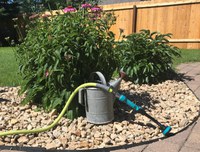Dakota Gardener: Water the Roots
(Click an image below to view a high-resolution image that can be downloaded)
By Carrie Knutson, NDSU Extension Agent, Grand Forks County
I prefer to drink room temperature water when I am thirsty.
The exception is when the weather is hot. Then I like ice water.
How do landscape plants prefer their water? Ice water definitely would not be on their list. The image of my plants ordering water according to their preference makes me laugh. Lately they would say, “Stop, we have enough!” but that is not true for all portions of the state.
Water is a resource that all living things need. Sometimes we need to supplement what Mother Nature provides. Do you know the correct way to water your thirsty landscape plants?
Ornamental flowers, trees, shrubs and vegetable plants take up water from the soil through their roots. When watering, concentrate the water at the base of the plant and don’t water the leaves. Keeping the plant leaves dry helps prevent leaf diseases. Water deeply and less often to encourage root growth and drought tolerance.
To avoid getting the leaves wet, water by hand or use a soaker hose or drip irrigation in vegetable gardens and flower beds. If you water with an overhead sprinkler, water in the morning so the leaves have time to dry during the day.
The amount of water a plant needs depends on your soil and the plant. Clay soils can hold more water and generally will need to be watered less frequently than sandy soils. Check your soil at a depth of 4 to 6 inches. If the soil is dry, now is the time to water.
Vegetable gardens will need about 1 inch of water or rain a week to maintain production. Containers may need daily watering. Perennial flowers might only need supplemental water during extended periods of dry weather. Using native plants or plants that tolerate dry conditions will help conserve water.
Newly planted trees and shrubs will need more water. A general recommendation is watering every day for one to two weeks after planting if the soil is dry, then every two to three days for the next few weeks. The same rule for checking the soil at a depth of 4 to 6 inches and watering if the soil is dry applies as well.
Don’t overwater. The soil should be moist but not soggy. A common rule is 10 gallons of water per week for every inch of caliper (diameter) of the trunk.
Regular rainfall will be enough for established trees and shrubs. However, they may benefit from additional water during extended periods of dry weather. Again, remember to water deeply to make sure the water soaks into the root area.
Use mulch to help conserve water in gardens, flower beds, large containers and around the base of trees and shrubs. Place 3 to 4 inches of mulch over the soil. Keep the mulch away from the stems of plants to prevent disease and pest damage. Happy gardening!
For more information, contact your local NDSU Extension agent. Find the Extension office for your county at.
NDSU Agriculture Communication - July 14, 2020
| Source: | Carrie Knutson, 701-780-8229, carrie.knutson@ndsu.edu |
|---|---|
| Editor: | Ellen Crawford, 701-231-5391, ellen.crawford@ndsu.edu |




